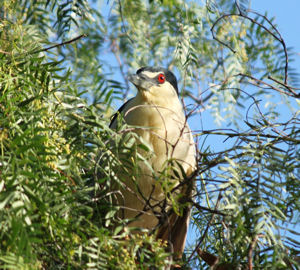
By Greg Dunne
June 26, 2012 (San Diego’s East County)--Although the Black-Crowned Night Heron is mostly nocturnal and not commonly seen by the casual observer, it can also be seen during the day.
This bird does not fit the typical body form of the heron family. Black-Crowned Night Herons are relatively stocky, about 25 inches tall with a wingspan of almost four feet. They have shorter bills, legs, and necks than their more familiar cousins, the Egrets and Blue Herons. They also have a black crown and back, gray wings and a white underside with 2-3 long thin white plumbs extending back from the rear of the head.
Adults have red eyes and yellow legs and feet. RED EYES AND YELLOW FEET!? Sounds like something out of a movie.
In addition, an interesting fact in regards to their scientific name Nvcticorax – this means “Night Raven” and refers to this species nocturnal habits and harsh crow-like call.
Besides fish, Black Crowned Night Herons eat a wide range of prey from aquatic invertebrates (crustacea, mussels, and squid), amphibians and reptiles (lizards and snakes) to land invertebrates (leeches, earthworms, and insects) including small mammals (rodents). I have heard some birders talk about Black Crowned Night Herons chasing squirrels and rabbits down their holes. They also eat plants and are not above eating carrion and rooting around garbage dumps.
The best nesting observations I have found in our East County are at Lindo Lake in Lakeside. There are many nests of Herons and Egrets in the Eucalyptus trees around the lake.
 They build a platform of sticks placed in trees or cattails. More than a dozen nests may be in a single tree. So, look up into the Eucalyptus trees around our lakes and if you see a large nest, it is probably the nest of a Heron or an Egret.
They build a platform of sticks placed in trees or cattails. More than a dozen nests may be in a single tree. So, look up into the Eucalyptus trees around our lakes and if you see a large nest, it is probably the nest of a Heron or an Egret. The eggs are laid at 2-day intervals, beginning 4-5 days after pair formation. Incubation, which lasts 24-26 days, is carried out by both adults. The clutch size is 3-5 eggs. The eggs are greenest on the first day and fade to pale blue or green after that.
On hot days, the parents wet their feathers, perhaps to keep the eggs cool. Both parents brood the young. After 2 weeks, the young leave the nest, although they do not go far. By 3 weeks, they can be found clustered at the tops of trees if they are disturbed. By Week 6-7, they fly well and depart for the feeding grounds. Adult Black-Crowned Night Herons do not recognize their own young and will accept and brood young from other nests.
The 2012 Mission Trails Regional Park photo contest has just finished. I was fortunate enough to win a second place for my Black-Crowned Night Heron. My hat is off to all the volunteers at the park, it is a lot of work and they do a great job for the community. Here is a link to the results of the Mission Trails Photo Contest. http://mtrp.org/photo_contest.asp











Recent comments